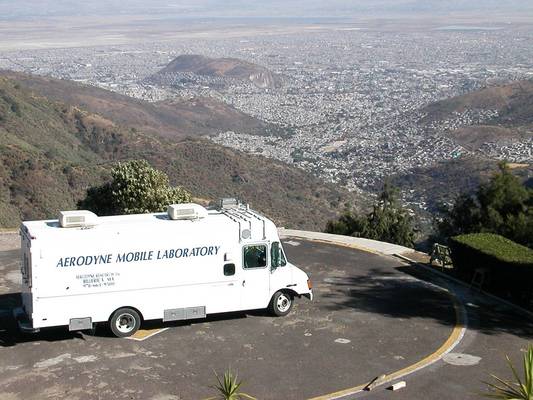
by Zahra Hirji Thursday, January 5, 2012

Researchers in a mobile air quality research lab, with a rare morning view of Mexico City not covered in smog. Charles Kolb, Aerodyne Research Inc.
Megacities — cities with populations equaling or greater than 10 million people — are producing an unprecedented amount of air pollution, according to scientists at the American Chemical Society's annual meeting in Washington, D.C., on Tuesday.
With more and more people moving out of the country and into cities each year, megacity air pollution is an emerging environmental and health problem, says Charles Kolb of Aerodyne Research Inc.’s Center for Aerosol and Cloud Chemistry, based in Billerica, Mass. The air pollution from megacities affects both the people in a city and in the surrounding regions up to 200 kilometers away, Kolb says. These air pollutants “can give you cancer” and are responsible for thousands of premature deaths a year, he adds.
Kolb teamed up with more than 360 scientists in the Megacity Initiative: Local and Global Research Observations (MILAGRO) campaign, a collaboration by 15 scientific institutions, universities and government agencies to study megacity emissions in March 2006. MILAGRO targeted Mexico City, which in 2007 was the second largest megacity in the world, with around 19 million people and a severe air pollution problem. Kolb and colleagues used a suite of instruments, including an aerosol mass spectrometer that measures the size and abundance of fine particles in the air, to collect both terrestrial and aerial observations to determine which parts of the city were producing what types of pollutants, to estimate the volume of pollutants initially produced and to determine how this volume changed over time as the pollutant plume moved downwind.
The team found multiple primary sources of air pollutants, from combustion exhaust products producing ammonium sulfate and nitrate to construction and road dust expelling dust and soot particles into the air. In the morning, these primary pollutants start collecting over the city. Over time, the plume of air pollutants rises and reacts with the sun, producing secondary photochemical pollutants such as nitrogen dioxide, ozone and inorganic aerosol particles. Both the primary and secondary pollutants generate the big air pollution plumes looming over big cities in the afternoon, Kolb says. By the end of the day, these plumes can rise into the troposphere by as much as two kilometers above the ground. From there, they are carried downwind and can affect surrounding regions.
“If a city only had to deal with primary pollutants it would be complex, but manageable,” Kolb says, but the secondary pollutants “produce much nastier things like nitrogen dioxide and ozone, called oxidants, that are responsible for things like trees dying in a city.”
Actual observations of those secondary organic aerosols in the atmosphere of Mexico City were higher than model predictions suggested they would be, Kolb says. But the researchers found a correlation between secondary oxidants and organic aerosols that might solve that conundrum: Both secondary oxidants and organic aerosols form at similar rates and volumes in the atmosphere. Therefore, the volume of secondary oxidants produced can help predict the volume of organic aerosols more accurately. The scientists are still studying how the pollution plume moves and evolves downwind.
© 2008-2021. All rights reserved. Any copying, redistribution or retransmission of any of the contents of this service without the expressed written permission of the American Geosciences Institute is expressly prohibited. Click here for all copyright requests.